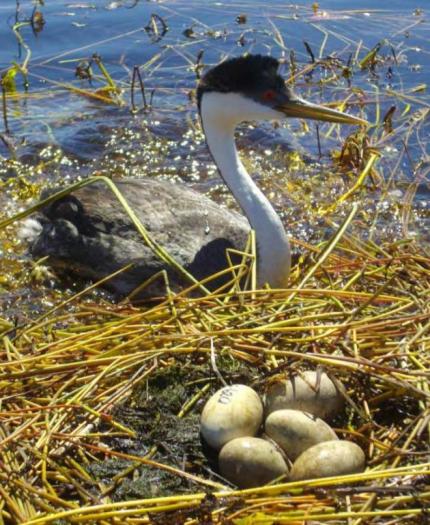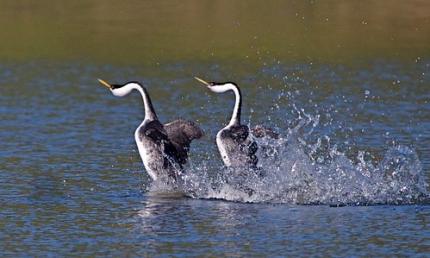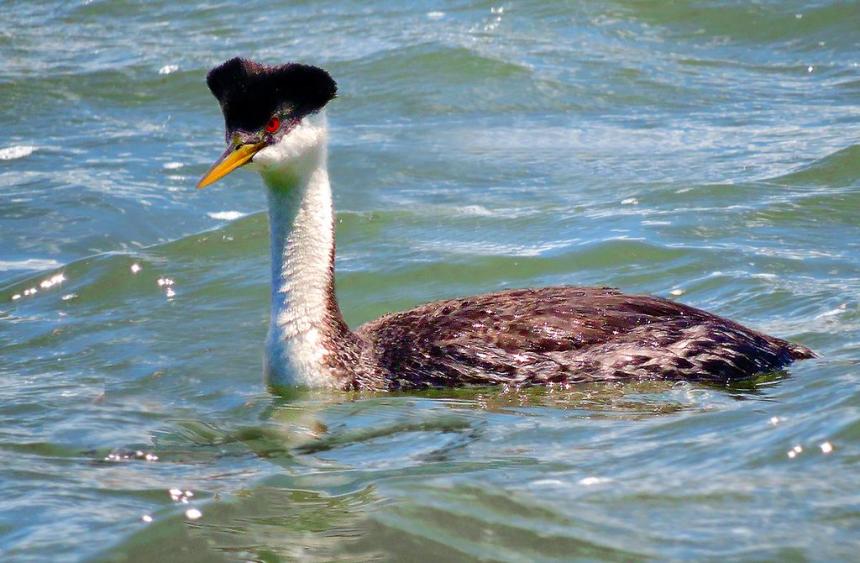Moderate-
High
The wintering population has remained in decline, whereas the breeding population continues to be impacted by several major threats. Wintering and breeding populations in Washington are likely to persist in the near-term, albeit at continuing reduced levels. Each of these populations and their habitats are strongly impacted by unique threats.
Description and Range
Physical description
The western grebe is a about 25 inches in length. It has a yellowish, thin beak, red eyes, a long neck, and lobed toes. The throat is white throat and white plumage extends down the underside of the throat and the underside of the body. The head has a black cap covering the eyes, extending down the topside of the neck and the topside of the body.
The western grebe may be confused with Clark's grebe. These two species are closely related piscivorous (fish-eating) aquatic birds that once were considered different color phases of the same species, and they do occasionally interbreed. Clark’s grebe was recognized as a distinct species in 1985.
Ecology and life history

Western grebes inhabit large freshwater lakes, reservoirs, and marshes during the summer breeding season, whereas primarily coastal marine areas with relatively sheltered waters are used in winter. Both types of habitats are occupied during spring and fall migration.
Spring migration is mainly from late April to early May. Fall migration extends from mid-September to November. Wintering birds occur in daytime flocks of up to hundreds or thousands of birds.
Nesting sites typically contain at least several square kilometers of open water and areas of emergent vegetation. Fidelity to breeding sites is often high among years. The species is gregarious, forming nesting colonies during the breeding season and often occurring in flocks of up to hundreds or thousands of birds at other times of the year. Floating nests are made from and anchored to emergent vegetation. Clutch size usually numbers two to four eggs.
Fish comprise 80 percent to nearly 100 percent of the diet year-round, with a wide variety of species eaten, along with salamanders, crustaceans, worms, and insects.
These grebes are best known for their elaborate courtship displays, particularly the "rushing ceremony", in which two birds often appear to ‘skate’ across the water side-by-side with heads held high.
Geographic range

Western grebes breed at suitable water bodies across the western U.S., southwestern Canada, and Mexico. Birds winter primarily along the Pacific coast from Vancouver Island to central Mexico.
Most nesting in Washington occurs in Grant County, with single nesting sites also known from Adams, Spokane, Okanogan, Lincoln, and possibly Ferry counties. Wintering birds are distributed throughout the Salish Sea, in embayments and nearshore waters along the outer coast, and in nearby freshwater lakes. Some of the birds wintering in Washington are known to breed in Manitoba. Small numbers of non-breeding individuals over-summer in Washington’s marine waters.
For a map of range-wide distribution and conservation status of this species, see NatureServe Explorer and the International Union for Conservation of Nature.
Climate vulnerability
Sensitivity to climate change
Moderate-
High
Western Grebes will likely be affected by disturbances to nesting habitats and declines in prey availability. Fluctuating water level (high or low), which could lead to declines in nesting habitats. In Washington, increased nest loss due to greater water drawdowns in reservoirs could happen because of the need for expanded agricultural irrigation caused by climate change. Declines in preferred forage fish prey (primarily Pacific herring) during the non-breeding season have led to a southern shift of the species to California, and further decreases in herring (e.g., due to warmer ocean temperatures) could result in additional grebe population declines. Increases in air temperature could also prompt shifts in grebe migration timing.
Exposure to climate change
Moderate
- Changes in water level (e.g. due to increased water drawdowns or changes in precipitation)
- Increased temperatures (air and ocean). >
Conservation
Conservation Threats and Actions Needed
- Agriculture and aquaculture side effects
- Threat: Major water drawdowns at reservoirs used by nesting colonies.
- Action Needed: Devise effective floating nest platforms; work with irrigation authorities to manage water levels to reduce impacts to grebes.
- Fish and wildlife habitat loss or degradation
- Threat: Boater activity and boat wakes at nesting colonies can destroy nests, spill eggs, or cause gull predation.
- Action Needed: Identify wake-free zones near breeding colonies.
- Resource information collection needs
- Threat: Prey base appears to have declined in the Salish Sea.
- Action Needed: Determine causes of declining forage fish availability; manage causes of forage fish decline to enhance prey populations.
- Energy development and distribution
- Threat: Oil spills in the wintering range.
- Action Needed: Expand safeguards to prevent oil spills.
- Overharvesting of biological resources
- Threat: Bycatch in gillnet fisheries in the western grebe's wintering range.
- Action Needed: Determine ongoing sources of bycatch and manage those fisheries to reduce bycatch.
See the Climate vulnerability section for information about the threats posed by climate change to the western grebe.
Resources
References
Gaydos, J. K. and D. R. Nysewander. 2009. Draft Washington state status report for the Clark’s and Western Grebe. Washington Department of Fish and Wildlife, Olympia, Washington.
Henny, C. J., L. J. Blus, and R. A. Grove. 1990. Western Grebe, Aechmophorus occidentalis, wintering biology and contaminant accumulation in Commencement Bay, Puget Sound, Washington. Canadian Field-Naturalist 104:460-472.
Hoenes, B. and R. Finger. 2011. Summary of Washington Department of Fish and Wildlife colonial waterbird surveys in Grant and Adams counties. Washington Department of Fish and Wildlife, Ephrata, Washington.
LaPorte, N., R. W. Storer, and G. L. Nuechterlein. 2013. Western Grebe (Aechmophorus occidentalis). Issue No. 26a in A. Poole, editor. The Birds of North America Online. Cornell Lab of Ornithology, Ithaca, New York.
Sauer, J. R., J. E. Hines, J. E. Fallon, K. L. Pardieck, D. J. Ziolkowski, Jr., and W. A. Link. 2014. The North American Breeding Bird Survey, results and analysis 1966 – 2012. Version 02.19.2014. USGS Patuxent Wildlife Research Center, Laurel, Maryland. http://www.mbr-pwrc.usgs.gov/bbs/bbs.html
Wahl, T. R. 2005. Western Grebe (Aechmophorus occidentalis). Pp 81-82 in T. R. Wahl, B. Tweit, and S. G. Mlodinow (eds.). Birds of Washington: status and distribution. Oregon State University Press, Corvallis, OR. 436 pp.


